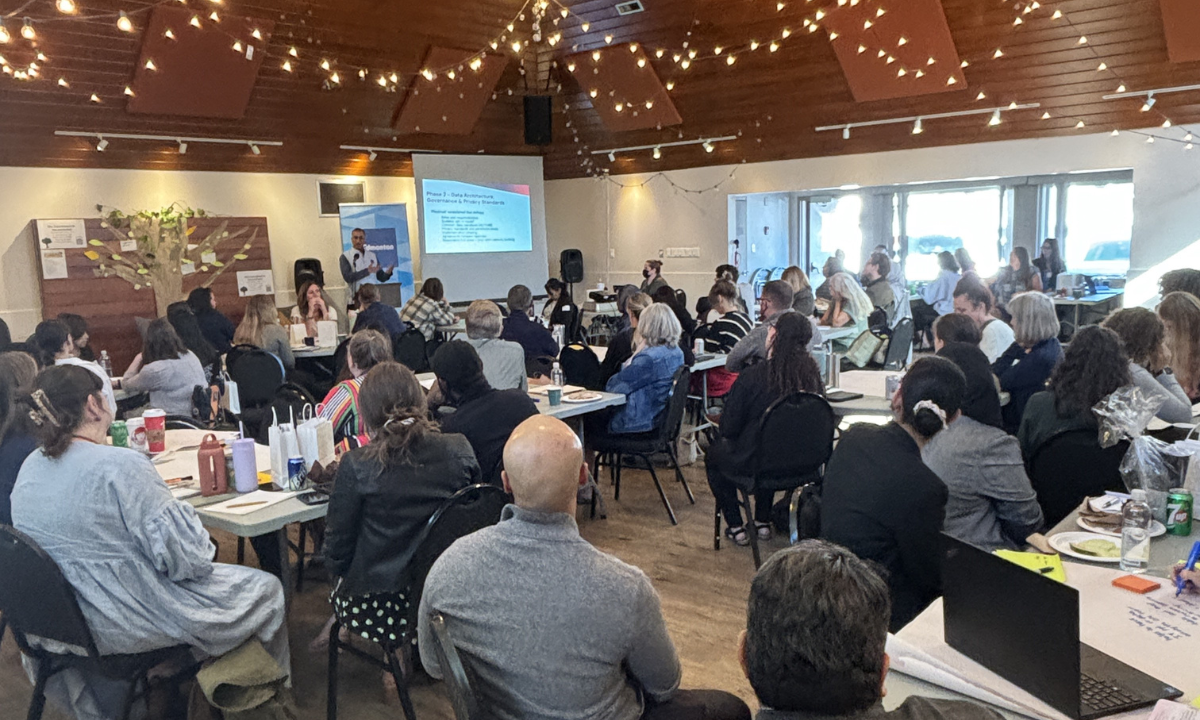How to break service silos with data: An Edmonton experiment
Why It Matters
Data sharing between non-profits is crucial for interoperability. However, often there are large entities involved in these collaborations – such as government, healthcare providers, or police services – who have much more mature data systems and different agendas.

When individuals enter into a cycle of vulnerability—be that a health issue, unemployment, poverty, or homelessness—they’re likely to find that these challenges overlap with one another—and so too do the multiple social service providers they engage to get help.
Sharing data can help individuals in vulnerable and precarious situations access services more efficiently without repeatedly going through an intake process, said Reg Joseph, CEO of Health Cities, a non-profit that advocates for technology in the Canadian healthcare sector.
In 2023, Health Cities announced a project called the Edmonton Community Data Warehouse, a means of helping social-serving agencies share data about the people they serve in Edmonton. While it is still in the early stages of developing and testing the data infrastructure, it’ll soon be rebranding as Elevate.
This hyperlocal data-sharing initiative includes the City of Edmonton and various social service agencies, such as the Bissell Centre, Islamic Family, Canadian Mental Health Association of Edmonton, Boyle Street, and Skills Society.
The data warehouse approach is hoped to allow the participating social service agencies to keep their own client management systems while funnelling information into a shared repository.
To be interoperable as a sector, non-profits need to be able to use the system without undergoing huge changes to their existing data and technical infrastructure, said Tyler Gajda, senior data administrator at Boyle Street, a community services organization in Edmonton that helps those experiencing homelessness and poverty.
“Our biggest obstacle to growing the system was it requires people to adopt,” she said.
“Large non-profits that already have their own system are not at all willing to change what they’re doing in order to join our system, or small non-profits that don’t have any system at all also don’t have the resources to move to our system.”
Coordinating a caring approach for those with complex needs is a positive shift for not only the individual at risk but also for social workers and funders themselves.
The former can quickly refer a client to other organizations and programs, while the latter can see a more high-level view of how their funding commitments are moving the dial on the most pressing issues in the community.
“Reporting from social service organizations is often inconsistent and fragmented, with each organization using its own reporting format and metrics,” said the team behind Elevate on its website.
“This makes it difficult for the program administrators to assess overall impact and make informed decisions on where to allocate resources.”
Policy and process cannot be skipped
One of the first and most crucial parts of developing the data warehouse project has been agreeing on exactly how much information organizations will share with one another, how they will maintain client privacy and data sovereignty, and how they will collect informed consent from clients to have their data shared between organizations.
PolicyWise, which focuses on research, data, and evaluation in the social purpose sector, was hired to help this coalition determine its data governance needs.
They needed to be able to share data in a way that was useful not only to the other non-profits in the coalition but also to keep their responsibility towards the client at the core of everything they did.
“When we first started doing some work on their individual organizational [data maturity] assessments, we discovered that the profiles across these organizations varied greatly,” said Jody Wolfe, research and policy manager at PolicyWise.
“There were some organizations who had participated in data sharing initiatives previously and had been doing work for eight to 10 years around building up their data infrastructure and skills. They had dedicated staff and so they tended to be a lot further along in all aspects of their data maturity.”
“And then there were some organizations that I would describe as a lot more uneven. So there might be pockets of skills and capabilities in the organization, but they tended to be quite isolated.”

In Elevate and other data-sharing collaboratives, data privacy is the common question that organizations ask, and ensuring everyone feels confident with the regulatory requirements, Wolfe said.
Organizations that have already joined Elevate, and those that will join in the future, will need to have a minimum viable privacy policy in place to be accepted into the collaborative.
Each organization in Elevate’s data repository should also explain to clients the benefits of sharing data and how it will support them, said Rebecca Rubuliak, director of continuous improvement and innovation at Skills Society, a charity that supports people with disabilities.
However, Rubuliak said they should also be prepared for clients to want to opt out or remove consent at any time, especially if they don’t want their information shared with a particular organization that has access to the repository.
If clients are faced with giving over their information or going back out into the cold, that cannot be considered informed consent, Gajda said.
“A lot of the organizations at the table are very proactive in making sure that withdrawal of consent [to data sharing] does not mean withdrawal from services.”
An easy build, a harder integration
In frontline work, it can be challenging to ensure the information social workers receive from clients is accurate and complete, Gajda said.
“Something as simple as spelling a name properly is not guaranteed,” she said.
“We deal with a population, especially at Boyle Street, that is very suspicious about putting names into a database, and so will often give us fake information – or just give different organizations different information,” Gajda explained.
When enabling data sharing, organizations essentially have to go through a fuzzy matching process to ensure their records paint a full picture of the same person, especially if the individual is likely being served by multiple agencies.
For the LGBTQ+ community, it’s also crucial the system is able to hold both their legal and chosen names.
Each organization will also need to see information about which services a client has already accessed, and what might be missing, so that they can make a meaningful contribution to the person’s overall journey to recovery, Gajda added.
Some of Elevate’s organizations have been involved in data sharing innovations before. For instance, Boyle Street designed and deployed a quick contact tracing system for those who may have been exposed to the virus in the early days of the pandemic.
These systems aren’t technologically laborious to make, Gajda said. What is more challenging is integrating it into systems that already exist within each non-profit. Health data in particular should be treated with more sensitivity as well.
Elevate is still in its testing phase, and recently Boyle Street and Skills Society ran a pilot test between the two organizations to see if they would be able to seamlessly share data between them.
They share some common clients and internal client management systems that are deliberately built not to share data externally.
“Although we work in the social services industries, we have very different mandates,” Gajda said.
“We work with almost a mutually exclusive set of individuals, but not entirely mutually exclusive.”
“And so the question is: if we were both connected to the system, would we be able to share meaningful data even though we work with almost none of the same people?”
To test this, the two organizations created fake profiles and populated them with the kind of information they would typically receive from their clientele. Both organizations then fed this information into the central database, and each received the other’s information about the client.
Useful for funders – why are they hesitant?
More often than not, non-profits are collecting data in a bid to stay accountable to funders, rather than as a means of self-improvement and assessment, Wolfe said.
Data-sharing – or other – collaborations can also be hard to get funded, Joseph said. Funders are generally looking to fund individual organizations, which can cause “splinters and duplication of work,” he said.
Funding models can “do the social services sector a disservice,” Joseph added, “because it’s based on outcomes [rather than] working on the abilities of these organizations to really move the needle in terms of where they want to go.”
There is a critical information gap when so many non-profits work in individual databases that need to be amalgamated to show the full scale of a particular issue, Gajda added.
“We don’t know how many people we have in common. We don’t really know the scope of the problem,” she said.
“If the Elevate system is actually able to amalgamate that information from every source, we could get a relatively accurate number on how many people are accessing services throughout the city.
“Every bit of information we have is telling us that our government’s perspective that there are about 3,000 to 4,000 homeless people [in Edmonton] is just wrong.[…] And so we’re being funded as if we serve 4,000 people a year, when we’re serving closer to 12,000.”
Health Cities estimates the seven organizations will be able to share information next year. From there, they hope to continue onboarding more non-profits into the system all over Alberta, whatever their level of data maturity.
“The key here is that this gets stronger and better the more organizations that are a part of it,” said Ryan Kelly, who helped Health Cities in the initial stages of putting Elevate together.
Part of the challenge that the teams are facing – and why it is a long time to start the data sharing component of the project – is that this doesn’t seem to have been attempted before in the sector. Gajda has been searching for guidance or examples, but has come up dry.
“We’ve essentially been inventing the wheel as we drive down the tracks.”

